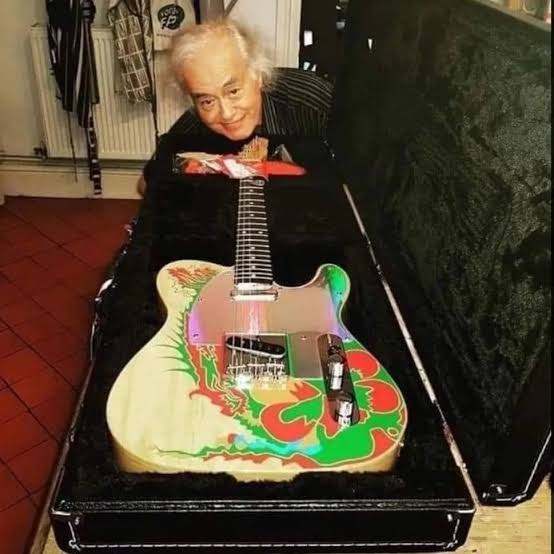Unveiling the Dragon’s Flames: Jimmy Page’s 1959 Telecaster, A Gift from Jeff Beck, Boasts a Rich History, Mirrored Inspiration, and a Legendary Design
In the world of rock music, certain instruments are more than just tools for producing sound—they become symbols of an artist’s creativity, persona, and legacy. One such instrument is Jimmy Page’s 1959 Fender Telecaster, a guitar that has played a central role in shaping the sound of Led Zeppelin and remains an iconic part of the legend of one of rock’s most innovative guitarists. What makes this guitar even more intriguing is its unique backstory, having been gifted to Page by Jeff Beck in the early 1960s, a gesture that marked the beginning of a long-lasting friendship between two of the greatest guitarists of their time.
The 1959 Fender Telecaster in question is often referred to as the “Dragon” guitar, a reference to the distinctive, fiery, and intricate design that adorns the body of the instrument. This one-of-a-kind artwork was a result of Page’s desire to make the Telecaster truly his own, a sentiment that is evident in the bold customizations that followed. The “Dragon” motif, which covers much of the body, has become synonymous with Page’s early career and serves as a visual representation of the power and raw energy that defined Led Zeppelin’s music.
The Gift from Jeff Beck
The story behind Jimmy Page’s 1959 Telecaster begins with the famous guitarist Jeff Beck. In the early ’60s, Beck, who was already an established figure as the lead guitarist for The Yardbirds, and Page, a highly sought-after session guitarist, formed a bond that transcended professional admiration. It was Jeff Beck who, recognizing Page’s potential and gifted him the guitar, giving Page the instrument that would become an essential part of his sound.
The Telecaster, with its bright, cutting tone, quickly became a go-to for Page, and although he had already begun his transition from a session musician to the guitarist for Led Zeppelin, the guitar remained one of his primary tools during the band’s early years. Its contribution to the band’s early works, especially on tracks like “Stairway to Heaven” and “Good Times Bad Times,” helped define the band’s sound during their formative period.
The Evolution of the Guitar
Page’s Telecaster wasn’t just any instrument. It was a telecaster that underwent significant changes, making it a perfect reflection of his approach to music—unconventional, dynamic, and always evolving. In the late ’60s, Page began customizing his Telecaster, including the addition of a unique dragon motif, which was painted by famed artist and friend, Tony Hill. The design was not just a simple paint job—it became a vibrant, fiery emblem that resonated with the intense emotions expressed through Page’s playing.
The design itself was inspired by Eastern philosophy and mythology, particularly the symbolism of dragons, which represent power, wisdom, and transformation. This idea mirrored Page’s musical journey during that time: a constant evolution, from blues-inspired rock to the more complex, experimental sound that would define Led Zeppelin. Page’s playing style also mirrored this transformation, moving away from traditional blues and rock solos to a more intricate, multi-layered style of guitar playing that would go on to influence generations of musicians.
A Mirror of Inspiration
The guitar itself became a direct extension of Page’s inspirations. Its sounds were at the forefront of the evolving rock scene, from the raw, grungy tones that defined the early Led Zeppelin sound to the sweeping, melodic passages that would later characterize their more sophisticated works. The 1959 Telecaster, with its legendary design and unmistakable tone, became a mirror to Page’s artistic and personal evolution—reflecting his interests in Eastern mysticism, his passion for creating new sounds, and his deepening connection with the world of music.
Page’s 1959 Telecaster also helped push boundaries with its tone and technique, helping him explore new dimensions of expression, especially with the band’s signature use of dynamic contrasts, intricate riffing, and intense, virtuosic solos. As a symbol of the collaboration between Beck and Page, the guitar also represents a pivotal moment in rock history—the coming together of two of the most important figures in music history at the time.
A Legendary Design and Legacy
Today, Page’s 1959 Telecaster remains one of the most legendary guitars in rock history, as much a symbol of his creativity and artistry as it is a relic of the golden age of rock and roll. From its original role as a simple session instrument to its transformation into a custom, fiery masterpiece, the guitar became a testament to Page’s constant pursuit of musical innovation and perfection. Its dragon-themed design continues to inspire, serving as a visual representation of the fire and passion that Jimmy Page brought to the world of rock music.
In the grander scheme, the Telecaster was not just an instrument in Page’s hands—it was the instrument that helped him build the foundation of Led Zeppelin’s colossal sound and legacy. As the years pass, the 1959 Telecaster’s legacy lives on, immortalized by Page’s inimitable playing style, and forever etched in the annals of rock history.
